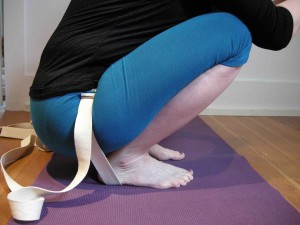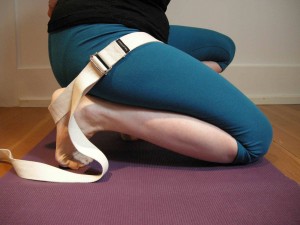Yes, my fascination with hip creases continues, and only grows deeper.
I just came back from a short road trip. When I got out of the car after several hours of sitting, I noticed that while I was a little stiff in my hips, I didn’t have the pain I used to get, deep in the hip creases, for the first few steps after standing up.
Thinking about it, I realized that it’s been a while since I felt that.
I can think of two reasons why that particular twinge might have disappeared.
• I now do my desk work using the Pomodoro Technique, so I’m no longer sitting for long periods at a time. I set my timer when I start, and after 25 minutes, I get up and walk around. The break is only five minutes, but it’s enough time for a stretch, or a small chore, such as flipping the towels from the washer to the dryer.
• I’m working with Malasana (garland pose or squat) in almost every practice I do.
On balance, I’m leaning toward Malasana as the explanation, which is why today’s Five-Minute Yoga Challenge is another way to work with this amazingly useful pose.
Although it might look like just a deeper way to sit down, squatting brings your hips into a position called open flexion, in which the ligaments that shorten while you sit are stretched out.
In particular, I’ve taken to doing a long squat with a belt looped deep into each hip crease and around each of my ankles.
As I press my heels into the straps, the hip crease moves deeper. And from the feeling of the straps in my hip creases, I’m better able to lift my side ribs and lengthen my spine.
Not only do you get the usual benefits of Malasana – toned abdominal muscles, relief from some backaches and a stretch for the ankles and groins – with the strap, the hip creases go deeper and become more alive. Day by day, I can see the difference that makes in other poses, as apparently dissimilar as Adho Mukha Virasana (child’s pose) and coming up into headstand with straight legs.
Yes, this does require that you have two straps. But yoga straps are far from expensive, and they last forever. You can buy eight-foot straps, the most useful kind, online from Halfmoon Yoga for $12.
Here’s how to do it:
Make a loop in each of the two yoga belts.
Slip one loop over each foot and bring the loop into your hip crease. Make sure the buckle on the loop faces up, and the tail of the loop goes toward the outside.
Then, one foot at a time, bring your heel into the loop, and tighten it. Bring the buckle to the thickest part of the muscle at the hip crease, toward the outer thigh.
You may want to have a chair nearby to help you balance.

You'll need to tighten the strap once you're fully in squat. Although you can't see it here, I have a strap on each hip crease and heel.
Once you have a strap around each foot, come up on your toes, tighten the loops, and let your heels descend to the floor.
If squatting is a challenge, put your hands on the chair seat for balance. The straps will act like a block to support your heels, so even if you usually put a yoga block under your heels, you won’t need to in this variation.
In squat, I’m happiest bracing my upper arms against my knees. This helps me lift my spine and move the spine between my shoulder blades deeper into my body.
Start with your feet hip distance apart. If your heels touch the floor, then after a few minutes, bring your feet together. You’ll need to tighten the straps when you do.
Ouch: Don’t do this pose if you have an existing knee injury, or if squatting causes you pain in your knees. Instead, find a teacher who can help you work safely.
Have you been working with Malasana? Noticed any surprising connections with other poses? Please share.
If this was your kind of post, you might also like:
10 Tips for Building a Home Yoga Practice
Half a Headstand with Three Blocks and a Wall
Use a Strap Around Your Hip Crease to Free Your Groins





